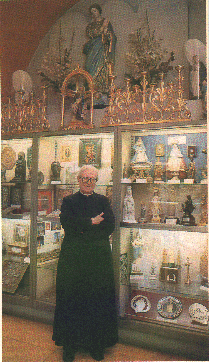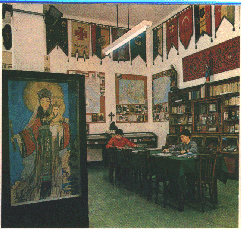|
THE PURPOSES OF THE CENTRE |
The centre aims
at documenting both ancient and modern devotion and worship of
the christian, mainly catholic population. At this point, it
would be useful, with the words of Paul VI, to present a ever
vibrant and functional aspect of the church which is now the
subject of great interest:
POPULAR RELIGIOUSNESS
OR PIETY.
The CSDM is
located in the Sanctuary's crypt, or rather the area dug out
of the Basilica's foundations. It is an area with varying height,
covering two architectonically valuable surfaces punctuated with niches and columns. The locations variety is caused in part by
a calculation error in the planning of the Shrine's foundations.
In fact, due to the geological nature of the land, it was necessary
to go deeper than foreseen during the excavation of the foundations.
The centre is currently
organised
into four basic areas:
niches and columns. The locations variety is caused in part by
a calculation error in the planning of the Shrine's foundations.
In fact, due to the geological nature of the land, it was necessary
to go deeper than foreseen during the excavation of the foundations.
The centre is currently
organised
into four basic areas:
that needs
some reorganisation due to the vast amount of material that has
poured in over the last decade;
including
the library and several collections of material that can
be consulted by scholars and enthusiasts, subject to notice;
not open
to the public, where objects of every type (statues, devotional
articles…), some of notable artistic and historical value,
are kept not having found space in the exhibition
area.
|
4. The Crypt of the Sanctuary, |
with large
space used for temporary exhibitions. Along the stairs that lead
to the exhibition halls, the visitor can notice ex-voto paintings
hanging of the walls. These are the only votive paintings in
theChurch Mary Help of Christians. There remains only one oil
ex-voto on tin dating from the period in which Don Bosco lived.
Some of the ex-voto on display were not however donated directly
to this Sanctuary, but are from unknown sources. They were acquired
from second-hand dealers and offered to the centre by people
who have remained anonymous.
Permanent display: divided into three sections:
|
1. Mary
and the devotion of the people: |
|
Gathers everything which refers to the
life of Mary and Christ, starting from the Nativity (both of
Christ and the Virgin) and ending at the foot of the Cross. Of particular interest are certain representations
of birthplaces from around the world, images of the Virgin in
clay, ceramic, wood and even…stamps.
In an ideal location one can view the painting of the Immaculate
commissioned by Don Bosco in 1882 by Giuseppe Rollini, the painter
who would later alfresco the cupola of the Basilica of Mary,
Our Lady Help of Christians. Also
of particular value, are the relics which display the Virgin
Grieving and the Passion in general, and particularly the Holy
Shroud: there is even the Holy
Nail, authenticated by the Abbot of the Holy Cross Basilica of
Rome in Jerusalem; grouped in specific glass cases are all the
major images of the Virgin from every part of the world and of
the most important apparitions including the
Virgin of Pilar, Lourdes, The Salette, Fatima and of Guadeloupe. One display case encloses a large variety of
rosaries, used in the past by diverse religious families. This
display even includes a rosary crown worn by Don Bosco. |
|
2. Mary
Our Help and Don Bosco: |

|
One can admire the first picture and sketch
of the painting of Mary Our Lady Help of Christians presented
to Don Bosco by the painter Lorenzone. On the front wall is a
gigantic photograph of the same painting including the names
of all the Apostles which surround the Virgin, and the saints.
The statues of the saints decorate the border of this painting.
Also shown are the large canvases
of E. Reffo, depicting San Francesco di Sales from 1896 and those
of P. G. Crida from 1995, depicting Saint Domenic Savio praying
in front of a statue of the Immaculate which was greatly admired
by Don Bosco and Mother Margherita. The
cases enclose other precious mementos like the Monstrance |
which was given as a gift by San
Giuseppe Cafasso to Don Bosco in 1858 for the Church of San Francesco
de Sales. The miracle cup of bilocation in France of Don Bosco
which occurred on October 14th, 1878; the canvas of Mary Our
Lady Help of Christians with Chinese features, painted in Peking
by the Salesian Father Mario Acquistapace.
Displayed on the tables, one can see photocopies of projects
for the construction of the Basilica of Mary Our Lady Help of
Christians presented by Don Bosco to the City Hall of Turin in
the 1860's. Also attracting
the curiosity of visitors is a small model of the Basilica of
Mary Our Lady Help of Christians, built to scale with over 14,300
matches by Franco Aloardi of Treviglio (BG); next to this is
a nicely displayed model of the house where Don Bosco was born
in Becchi, built perfectly to scale with real bricks by Rapolla
Michele from Venosa (PZ).


| HOME PAGE | BASILICA
| SAN GIOVANNI BOSCO | CAPPELLA
PINARDI | S. FRANCESCO DI SALES
| CAMERETTE | A.D.M.A.
| RIVISTA M. A. | C.
S. D. M. | INFO VALDOCCO |
VISIT Nr. 
 niches and columns. The locations variety is caused in part by
a calculation error in the planning of the Shrine's foundations.
In fact, due to the geological nature of the land, it was necessary
to go deeper than foreseen during the excavation of the foundations.
The centre is currently
organised
into four basic areas:
niches and columns. The locations variety is caused in part by
a calculation error in the planning of the Shrine's foundations.
In fact, due to the geological nature of the land, it was necessary
to go deeper than foreseen during the excavation of the foundations.
The centre is currently
organised
into four basic areas: